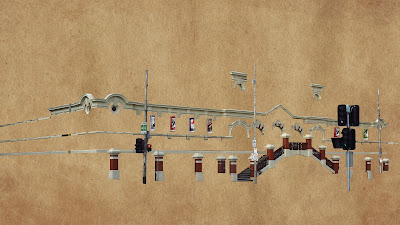Where in Melbourne Puzzle - August 2013.
THIS PUZZLE HAS BEEN REVEALED
Clue 1 This is a place in the heart of Melbourne that except for a brief period in its history is still being used for what it was originally built for.
Clue 2 One of the most distinctive Edwardian Baroque buildings in Melbourne, originally built because people did something in the Yarra river which at the time was quite unhealthy. Patronage of the establishment dropped off significantly after the Melbourne Olympic Games in 1956.
Clue 3 At the time the building was built, it provided segregated facilities for men and women.
LAST CLUE This building was a necessary feature of daily life in early Melbourne when many houses had little provision for private bathing facilities.
And now, for the puzzle solution :
The picture is of Melbourne City Baths at the top of Swanston Street, Melbourne.
This popular health and fitness centre opened for public bathing on 9 January 1860, when Melbourne's primary water supply, the Yarra River, was polluted, water-borne diseases were endemic and bathrooms were rare.
Goodman Teale artist
born 1819; died Kyneton, Victoria, 1885
Nathaniel Whitlock engraver
active London c. 1830–1860
The city of Melbourne, Australia 1855
engraving and watercolour
29.1 x 53.4 cm
The University of Melbourne Art Collection. Gift of the Sir Russell and Mab Grimwade Bequest, 1973
In the first year a reputed 79 096 males and 2950 females enjoyed the new amenities, located on the triangular site at the corner of Swanston and Franklin streets.
The building included a swimming pool, public washhouse, family bathrooms, and first- and second-class 'slipper' bathrooms all with separate male and female facilities. Municipal baths were a common and necessary feature of daily life in early Melbourne when many houses had little provision for private bathing facilities.
However, by 1886 the facility was in decline. Inspectors reported 'an unwholesome scum' on the surface of the water and general dilapidation, and the building was closed in 1899.
The current building opened on 23 March 1904, to a competition-winning design by E.J. and J.J. Clark. Mixed bathing was introduced in 1947. It included two large swimming baths and associated changing facilities, as well as slipper baths, spray baths, Jewish Mikva baths and Turkish Baths. The symmetrical front façade clearly indicates the division of men's and women's facilities on either side of the entry bay.
The City Baths were very popular throughout the early twentieth century, however by the 1940s the facility had once again fallen into disrepair. Degradation continued after the Olympic Games in 1956 as the construction of suburban pools reduced patronage at the City Baths.
Attempts to close and demolish the building in the 1970's failed when the Builders' Labourers Federation stopped Melbourne City Council's planned demolition by designating the site a 'worker's pool'.
Following a $4 million renovation the baths were officially reopened on 14 August 1983 including the addition of spas, saunas, squash courts and a gymnasium.
Edwardian Baroque in style, the City Baths building is distinctive in its use of red brick and contrasting cement render mouldings. The two storey central entrance bay incorporates arched openings emphasised by banded voussoirs, a broken pedimented entry and roofed belvederes. Flanking single storey wings also incorporate cupolas at the corner bays.
Today, Melbourne City Baths is a privately owned leading health, fitness and wellness centre and the building has become a significant historical icon visited by thousands of national and international tourists. The uniqueness of the building and the significance it holds for so many Victorians has also prompted theatre groups, television programs and fashion magazines to use the baths as the setting for their productions, films and photographic shoots.
The building is listed on the Victorian Heritage Register.
research links :
onmydoorstep
insidehistorymagazine issue 17
melbournecitybaths-history
Wikipedia
This page was last updated on the 2nd of September 2013.









